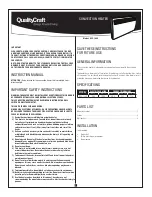
61
ENGLISH
Product maintenance
1 . Water quality management
- The plate type heat exchanger is impossible to disassemble for cleaning or to replace parts . To prevent corrosion or
water scale on the plate type heat exchanger, you must manage the cooling water quality in compliance with national
standards .
- If the temperature of water is higher than room temperature, make sure to keep the concentration of chloride ion
below 100 ppm to prevent corrosion and the water hardness should be below 150 mCaCO
3
/L to prevent water scale .
When scale inhibitor is used, make sure to use the ones that does not cause corrosion to stainless steel and copper .
2 . Amount of water flow management
- Insufficient amount of water flow will lead to accidents related to frozen plate type heat exchanger . Check to make sure
if there is any decrease in amount of water flow due to blocked strainer, problem on air ventilation or circulation pump
after checking the temperature/pressure difference between the inlet and outlet of the plate type heat exchanger . If
the temperature/pressure difference exceeds optimal range, stop the operation until cause is taken care before re-start
the operation .
3 . Precautions on plate type heat exchanger maintenance
f
Make sure to tell the user to keep this installation manual .
1) When the product was not operated for long period of time, check the followings .
- Check the water to see if the water quality meets the standard .
- Clean the strainer .
- Check if the amount of water flow is appropriate . (The Flow switch starts to operate at a minimum flow rate of 12 liters
per minute .)
- Check to see if there is any problems on the water pressure, amount of water and the water temperature at inlet/outlet .
2) The plate type heat exchanger is impossible to disassemble for cleaning or to replace parts . Therefore it has to be
cleaned by following methods .
- Check if there is any cleaning hole for chemical cleaning at the inlet water pipe . For water scale cleaning use diluted
(down to 5 %) citric acid, oxalic acid, acetic acid, phosphoric acid . However, do not use a cleaning solution containing
hydrochloric acid, sulfuric acid or nitric acid since they are highly corrosive .
- Check if there is valve on the inlet/outlet of the plate type heat exchanger .
- Connect a exclusive pipe for cleaning to the inlet/outlet pipe of the plate type heat exchanger and fill the detergent
at the temperature of 50 ~ 60 ˚C (122 ~ 140 ˚F) and circulate the detergent for about 2~5 hours . Cleaning time can be
different depending on the temperature of detergent or degree of water scale . Judge the degree of water scale removal
by the color of water detergent .
- After cleaning, discharge the detergent within the plate type heat exchanger and fill the plate type heat exchanger
with a water mixed with 1~2 % of sodium hydroxide (NaOH) or sodium bicarbonate (NAHCO
3
) . Circulate the water
mixture for 15~20 minutes to neutralize .
- After neutralizing the pipes, rinse the plate type heat exchanger with distilled water .
- If you are using the detergent sold at local retail stores, make sure that it doesn't cause any corrosion to the stainless
steel .
- For detail information on cleaning method (and proper use of detergent), contact the detergent manufacturer .
3) After cleaning, check to see if it is possible to operate normally .
DB68-12327A-00_IM_DVM Hydro HT_AA_EN_.indd 61
DB68-12327A-00_IM_DVM Hydro HT_AA_EN_.indd 61
2023-06-15 오전 10:37:38
2023-06-15 오전 10:37:38










































